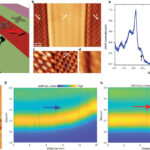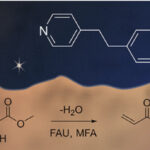2023-01-09 ペンシルベニア州立大学(PennState)
超潤滑性と呼ばれる、2つの接触面の摩擦がほぼ消失する材料状態は、摩擦の2大欠点であるエネルギーコストとデバイスの磨耗を低減する可能性があるため、材料研究者が長年研究してきた現象である。しかし、同じ装置内でも摩擦が必要な場合があり、超潤滑性のオン・オフを切り替えることができれば、複数の実用的な工学用途に恩恵を与えることができる。
ペンシルベニア州立大学化学工学科のSeong Kim著名教授および副学長と、浙江大学流体動力・メカトロシステム国家重点実験室および機械工学科のZhe Chen研究員は、Applied Materials Todayの研究において、この超潤滑性スイッチが湿度にあるのではないかと提案している。具体的には、水蒸気と、有機化合物の一種であるフェノール中の水蒸気である。
彼らは、グラファイトの基底面上に酸化シリコンのプローブを用いて、これがどのように可能であるかを実証したのである。シリコンは、微小な可動部をもつ微小電気機械システム(MEMS)によく使われており、Apple Watchや携帯電話に搭載されている加速度センサーなど、速度を計測するためのデバイスに利用されている。
研究チームは、シリカチップとグラフェン表面の間のナノスケールの超低摩擦性を、環境からのさまざまな分子の吸着によって調整できることを発見した。超低摩擦性は、水蒸気で25倍、フェノール蒸気で45倍になることを発見した。シリカ表面に水を吸着させると、固体状態である氷と同様のナノ構造が形成される。
<関連情報>
- https://www.psu.edu/news/materials-research-institute/story/humidity-may-be-key-super-lubricity-switch/
- https://www.sciencedirect.com/science/article/abs/pii/S2352940722002499
分子吸着による超潤滑性のチューニング Tuning super-lubricity via molecular adsorption
Zhe Chen,Seong H.Kim
Applied Materials Today Available online :9 August 2022
DOI:https://doi.org/10.1016/j.apmt.2022.101615

Highlights
- •Nanoscale friction between Si tip and graphite basal plane is measured in various vapors.
- •Atomic stick-slip motions, as well as the lateral contact stiffness, are resolved.
- •The super-lubricity can be enhanced in n-pentanol vapor, but suppressed in phenol and water vapors.
Abstract
The state of vanishing friction known as super-lubricity is highly desirable to reduce parasitic energy loss. However, without efficient means to turn on and off the super-lubricity, it would be difficult to realize its full potential in engineering applications. Here we report that the nanoscale super-lubricity between amorphous silica tip and graphite basal plane can be tuned by physisorbing various molecules from the environment. In particular, the super-low fiction can be further reduced by about 54% in n-pentanol vapor, but increases by around 25 and 45 times in water and phenol vapor respectively. The vapor molecules influence the friction by adsorbing onto the silica surface and being entrained into the sliding interface. Based on the structures of adsorbed molecules, it could be deduced that adsorbates with high conformational entropy can suppress the interfacial commensuration and enhance the super-lubricity, while the ones that can facilitate commensurate interactions with the graphite surface increase friction. This finding provides the basic principle enabling on-demand control of friction into and out of the super-lubricious state of solid interface.



